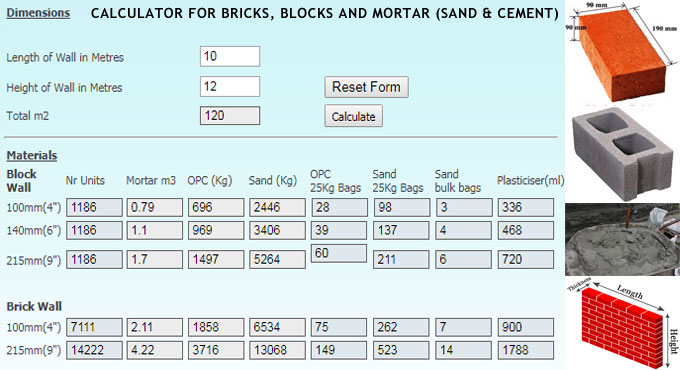
The online calculator for bricks, blocks and mortar (sand & cement)
This Calculator/Estimator is used to determine the quantities of bricks, blocks and mortar (sand & cement) which are necessary for a specified area of metric bricks (single & double skins) and 100mm, 140mm & 215mm blockwork. The calculator also offers rough brick work prices.
In order to use the calculator, just put the dimensions in the white fields under and press calculate to get the output.
This Calculator/Estimator will provide the quantities of bricks, blocks and mortar (sand & cement) required for a given area for metric bricks.
Brick Mortar
? Mix Design - Mortar is formed by blending binder (cement or lime) with sand. It may or may not contain fillers or additives like plasticiser. The binder or filler makes the mortar design superior by filling the voids in perfectly graded sand.
This is what produces the ratio. Normally, it is suggested to employ the weakest possible mortar mix that is well matched with the brick or block being utilized and the exposure, until or else specified. This mortar mix will demonstrate less shrinkage and create a powerful brick/mortar bond, weaker mixes also likely to be more compliant.
? Aesthetics - The entire look of the brickwork is impacted by the color and joint profile. There are various options for the users like contrast against the brickwork or blend perfectly.
? Durability - Water and frost are considered as the prime components that will influence brickwork. As the frost resistance of the mature mortar is raised with the ratio of cement, designation (i) and (ii) mortars are treated as most effective for critically exposed operations like in copings, cappings and cills and below DPC level.
Designation (i) mortars are suitable for paving. With the existence of high levels of dissolvable salts and/or the brickwork is liable to be saturated for periods then the Ordinary Portland Cement will have to be substituted with sulphate-resisting Portland cement.
? Rain ? Protection against rain can be obtained or raised with good adhesion, well filled joints and a perfect joint profile. Tooled bucket handle or weather struck joints are considered as most suitable for exposed areas. Even as recessed joints are right for reasonable exposure.
? Structural - In design calculations, it is accepted that both the compressive strength value of the exact mortar designation is obtained in practice as well as the joints are entirely filled with mortar.
? Adhesion - Strength of bond is influenced with the suction rate of the brick, the mortar components, water content and the weather. When the suction rate of a brick surpasses the optimum value of 1.5kg/m2/min, it is suggested that the bricks are moisten before laying, specifically in hot & dry weather conditions.
For online calculation and more information, go through the following link www.source4me.co.uk


